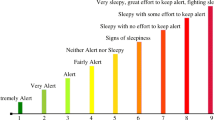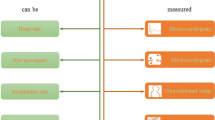Abstract
It is estimated that 10–30 % of road fatalities are related to drowsy driving. Driver’s drowsiness detection based on biological and vehicle signals is being studied in preventive car safety. Autonomous nervous system activity, which can be measured noninvasively from the heart rate variability (HRV) signal obtained from surface electrocardiogram, presents alterations during stress, extreme fatigue and drowsiness episodes. We hypothesized that these alterations manifest on HRV and thus could be used to detect driver’s drowsiness. We analyzed three driving databases in which drivers presented different sleep-deprivation levels, and in which each driving minute was annotated as drowsy or awake. We developed two different drowsiness detectors based on HRV. While the drowsiness episodes detector assessed each minute of driving as “awake” or “drowsy” with seven HRV derived features (positive predictive value 0.96, sensitivity 0.59, specificity 0.98 on 3475 min of driving), the sleep-deprivation detector discerned if a driver was suitable for driving or not, at driving onset, as function of his sleep-deprivation state. Sleep-deprivation state was estimated from the first three minutes of driving using only one HRV feature (positive predictive value 0.80, sensitivity 0.62, specificity 0.88 on 30 drivers). Incorporating drowsiness assessment based on HRV signal may add significant improvements to existing car safety systems.






Similar content being viewed by others
References
Acharya UR, Joseph KP, Kannathal N, Lim CM, Suri JS (2006) Heart rate variability: a review. Med Biol Eng Comput 44(12):1031–1051
Baharav A, Kotagal S, Gibbons V, Rubin BK, Pratt G, Karin J, Akselrod S (1995) Fluctuations in autonomic nervous activity during sleep displayed by power spectrum analysis of heart rate variability. Neurology 45(6):1183–1187
Bailón R, Laouini G, Grao C, Orini M, Laguna P, Meste O (2011) The integral pulse frequency modulation model with time-varying threshold: Application to heart rate variability analysis during exercise stress testing. IEEE Trans Biomed Eng 58(3):642–652
Bailón R, Mainardi L, Orini M, Sörnmo L, Laguna P (2010) Analysis of heart rate variability during exercise stress testing using respiratory information. Biomed Signal Process Control 5(4):299–310
Bailón R, Sörnmo L, Laguna P (2006) ECG-derived respiratory frequency estimation, pp 215–244. Artech House Inc
Catarino R, Spratley J, Catarino I, Lunet N, Pais-Clemente M (2013) Sleepiness and sleep-disordered breathing in truck drivers. Sleep Breath pp 1–10
Dirección General de Tráfico: La fatiga causa el 30% de los accidentes de tráfico en españa (2008)
Drake C, Roehrs T, Breslau N, Johnson E, Jefferson C, Scofield H, Roth T (2010) The 10-year risk of verified motor vehicle crashes in relation to physiologic sleepiness. Sleep 33(6):745
Furman G, Baharav A, Cahan C, Akselrod S (2008) Early detection of falling asleep at the wheel: a heart rate variability approach. Comput Cardiol, pp 1109–112
Gunzelmann G, Gross JB, Gluck KA, Dinges DF (2009) Sleep deprivation and sustained attention performance: integrating mathematical and cognitive modeling. Cogn Sci 33(5):880–910
Hodes and Associates (1972) The stanford sleepiness scale. In: Eleventh annual meeting of the association for the psychophysiological study of sleep, 1972
Johns M (1991) A new method for measuring daytime sleepiness: the epworth sleepiness scale. Sleep 6:540–545
Lachenbruch PA, Goldstein M (1979) Discriminant analysis. Biometrics 35(1): 69–85. http://www.jstor.org/stable/2529937
Li G, Chung WY (2013) Detection of driver drowsiness using wavelet analysis of heart rate variability and a support vector machine classifier. Sensors 13(12):16494–16511
Martínez JP, Almeida R, Olmos S, Rocha AP, Laguna P (2004) A wavelet-based ecg delineator: evaluation on standard databases. IEEE Trans Biomed Eng 51(4):570–581
Mateo J, Laguna P (2003) Analysis of heart rate variability in the presence of ectopic beats using the heart timing signal. IEEE Trans Biomed Eng 50(3):334–343
Michail E, Kokonozi A, Chouvarda I, Maglaveras N (2008) Eeg and hrv markers of sleepiness and loss of control during car driving. In: Conf Proc IEEE Eng Med Biol Soc, pp 2566 –2569
Paik H (2000) Comments on neural networks. Sociol Methods Res 28(4):425–453. doi:10.1177/0049124100028004002. http://smr.sagepub.com/content/28/4/425.abstract
Patel M, Lal S, Kavanagh D, Rossiter P (2011) Applying neural network analysis on heart rate variability data to assess driver fatigue. Expert Syst Appl 38(6):7235–7242
Philip P, Akerstedt T (2006) Transport and industrial safety, how are they affected by sleepiness and sleep restriction? Sleep Med Rev 10(5):347–356
Ripley BD (2007) Linear discriminant analysis. Pattern recognition and neural networks. Cambridge University Press, Cambridge, pp 91–120
Rodríguez-Ibáñez N, García-González M, Fernández-Chimeno M, Ramos-Castro J (2011) Drowsiness detection by thoracic effort signal analysis in real driving environments. In: Conf Proc IEEE Eng Med Biol Soc
Shinar Z, Akselrod S, Dagan Y, Baharav A (2006) Autonomic changes during wake-sleep transition: a heart rate variability based approach. Auton Neurosci 130:17–27
Strohl K (2012) Assessments of driving risk in sleep apnea., Respiratory medicineHumana Press, USA
Task Force of ESC and NASPE (1996) Heart rate variability : standards of measurement, physiological interpretation, and clinical use. Circulation 93(5):1043–1065
R Development Core Team (2011) R: a language and environment for statistical computing. R Foundation for Statistical Computing, Vienna, Austria
Valenza G, Citi L, Barbieri R (2014) Estimation of instantaneous complex dynamics through lyapunov exponents: A study on heartbeat dynamics. PLoS One 9(8):e105,622. doi:10.1371/journal.pone.0105622
Verster JC, Taillard J, Sagaspe P, Olivier B, Philip P (2011) Prolonged nocturnal driving can be as dangerous as severe alcohol-impaired driving. J Sleep Res 20(4):585–588
Vicente J, Laguna P, Bartra A, Bailón R (2011) Detection of driver’s drowsiness by means of hrv analysis. Comput Cardiol
Wegman F (2013) Road Safety Annual Report. Tech. rep, International Traffic Safety Data and Analysis Group
Wessel N, Voss A, Malberg H, Ziehmann C, Voss HU, Schirdewan A, Meyerfeldt U, Kurths J (2000) Nonlinear analysis of complex phenomena in cardiological data. Herzschrittmachertherapie und Elektrophysiologie 11(3):159–173
Willis D, Waller P, Stutts J, Roth T (1998) Drowsy driving and automobile crashes. Tech Rep DOT HS 808 707, National Highway Traffic Safety Administration
Yang G, Lin Y, Bhattacharya P (2010) A driver fatigue recognition model based on information fusion and dynamic bayesian network. Inf Sci (Ny) 180(10):1942–1954
Acknowledgments
This work was supported in part by the Ministerio de Ciencia e Innovación, Spain, under Projects TIN2014-53567-R; TEC2013-42140-R, TRA2009-0127 and UZ2014-TEC-01, in part by Grupo Consolidado BSICoS from DGA (Aragón), European Social Fund (EU) and CIBER de Bioingeniería, Biomateriales y Nanomedicina, in part by an appointment to the Research Participation Program at the Center for Devices and Radiological Health and the Center for Drug Evaluation and Research administered by the Oak Ridge Institute for Science and Education through an interagency agreement between the U.S. Department of Energy and the U.S. Food and Drug Administration. The computation was performed by the ICTS 0707NANBIOSIS, by the High Performance Computing Unit of the CIBER in Bioengineering, Biomaterials and Nanomedicine (CIBER-BBN) at the University of Zaragoza.
Author information
Authors and Affiliations
Corresponding author
Electronic supplementary material
Below is the link to the electronic supplementary material.
Rights and permissions
About this article
Cite this article
Vicente, J., Laguna, P., Bartra, A. et al. Drowsiness detection using heart rate variability. Med Biol Eng Comput 54, 927–937 (2016). https://doi.org/10.1007/s11517-015-1448-7
Received:
Accepted:
Published:
Issue Date:
DOI: https://doi.org/10.1007/s11517-015-1448-7




